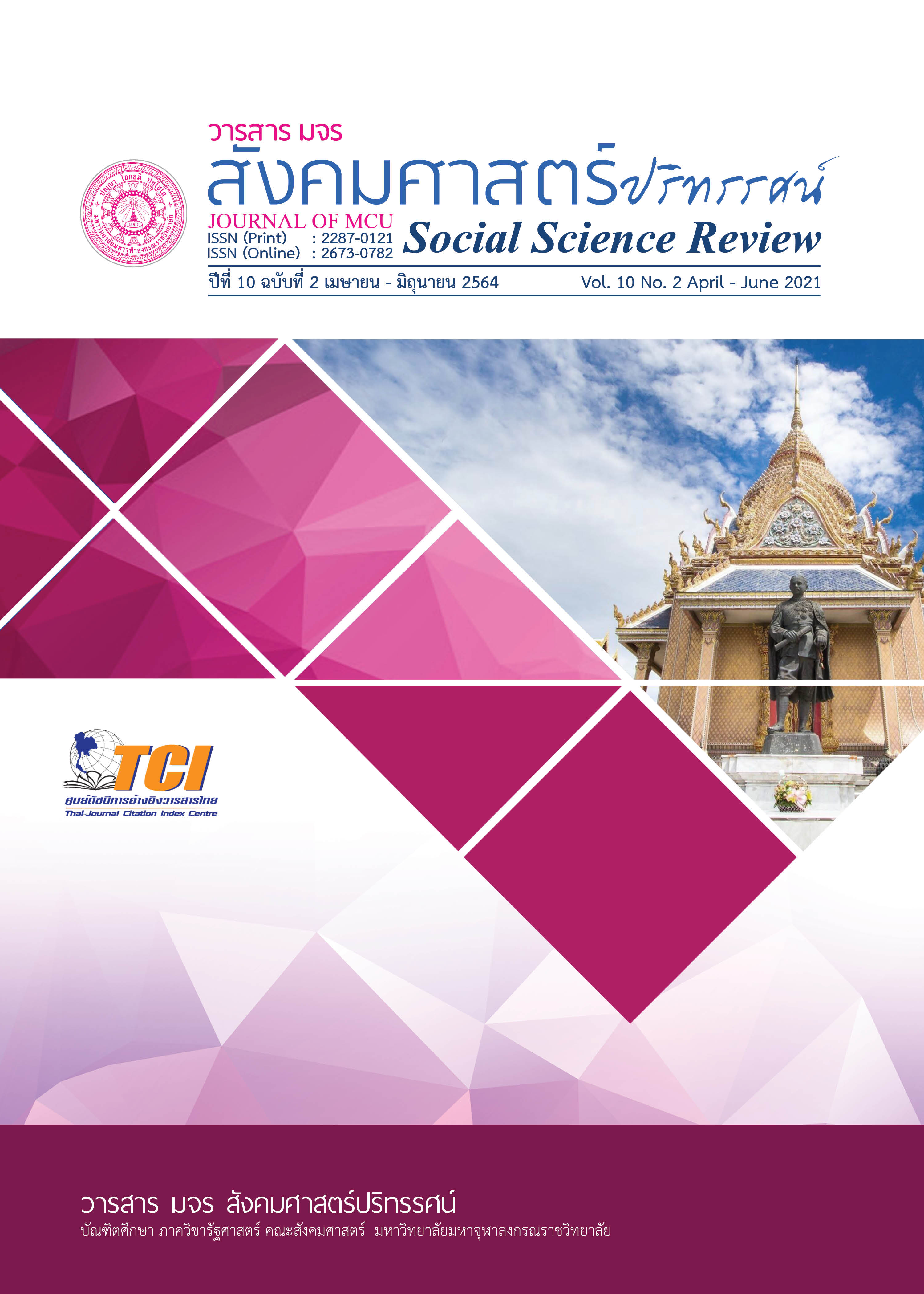การพัฒนาหลักสูตรสร้างเสริมการแก้ปัญหาอนาคตในการเตรียมความพร้อมรับมือภัยพิบัติแผ่นดินไหว โดยใช้รูปแบบการเรียนการสอนตามแนวคิดของทอร์แรนซ์ สำหรับนักเรียนประถมศึกษาตอนปลาย
คำสำคัญ:
การพัฒนาหลักสูตร, การคิดแก้ปัญหาอนาคตตามแนวคิดของทอร์แรนซ์, การเตรียมความพร้อมรับมือภัยพิบัติแผ่นดินไหวบทคัดย่อ
บทความวิจัยนี้มีวัตถุประสงค์คือ 1. เพื่อสร้างและหาประสิทธิผลของหลักสูตรสร้างเสริมการแก้ปัญหาอนาคตในการเตรียมความพร้อมรับมือภัยพิบัติแผ่นดินไหว โดยใช้รูปแบบการเรียนการสอนตามแนวคิดของทอร์แรนซ์ สำหรับนักเรียนประถมศึกษาตอนปลาย และ 2. เพื่อศึกษาผลการใช้หลักสูตรสร้างเสริมการแก้ปัญหาอนาคตในการเตรียมความพร้อมรับมือภัยพิบัติแผ่นดินไหว โดยใช้รูปแบบการเรียนการสอนตามแนวคิดของทอร์แรนซ์ สำหรับนักเรียนประถมศึกษาตอนปลาย เป็นการวิจัยแบบกึ่งทดลอง กลุ่มตัวอย่างที่ใช้ในการวิจัย คือ นักเรียนชั้นประถมศึกษาตอนปลาย ภาคเรียนที่ 2 ปีการศึกษา 2563 โรงเรียนบ้านน้ำชำ(วิชัยชนานุเคราะห์) สังกัดสำนักงานเขตพื้นที่การศึกษาประถมศึกษาแพร่ เขต 1 จำนวน 20 คน เครื่องมือที่ใช้ในการวิจัย ได้แก่ 1. หลักสูตรฯ 2. คู่มือการใช้หลักสูตรฯ 3. แบบทดสอบวัดกระบวนการคิดแก้ปัญหาอนาคตในการรับมือภัยพิบัติแผ่นดินไหว สำหรับนักเรียนประถมศึกษาตอนปลาย และ 4. เกณฑ์การประเมินกระบวนการคิดแก้ปัญหาอนาคตในการเตรียมความพร้อมรับมือกับภัยพิบัติแผ่นดินไหว สำหรับนักเรียนประถมศึกษาตอนปลาย วิเคราะห์ข้อมูลโดยการหาค่าร้อยละ ค่าเฉลี่ย ส่วนเบี่ยงเบนมาตรฐาน และร้อยละพัฒนาการสัมพัทธ์
ผลการวิจัยพบว่า 1. หลักสูตรสร้างเสริมการแก้ปัญหาอนาคตในการเตรียมความพร้อมรับมือภัยพิบัติแผ่นดินไหว โดยใช้รูปแบบการเรียนการสอนตามแนวคิดของทอร์แรนซ์ สำหรับนักเรียนประถมศึกษาตอนปลาย มี 10 องค์ประกอบ ดังนี้ 1. ความเป็นมาและความสำคัญ 2. หลักการของหลักสูตรฯ 3. จุดมุ่งหมายของหลักสูตรฯ 4. สมรรถนะสำคัญของผู้เรียน 5. คุณลักษณะอันพึงประสงค์ 6. โครงสร้างเนื้อหาของหลักสูตรฯ 7. แนวทางการจัดการเรียนรู้ 8. สื่อการเรียนรู้ 9. การวัดและประเมินผลการเรียนรู้ และ 10. เงื่อนไขในการนำหลักสูตรไปใช้ ซึ่งมีค่าเฉลี่ยความเหมาะสมของหลักสูตรฯ อยู่ในระดับ มาก (= 4.43, S.D. = 0.57) คู่มือการใช้หลักสูตรฯ มีค่าเฉลี่ยความเหมาะสมอยู่ในระดับ มากที่สุด (
= 4.65, S.D. = 0.50) ผลการหาประสิทธิผลของหลักสูตรฯ มีค่าดัชนีประสิทธิผลอยู่ที่ 0.6054 2. การศึกษาผลการใช้หลักสูตรฯ พบว่านักเรียนมีคะแนนพัฒนาการหลังการจัดการเรียนรู้ตามหลักสูตรฯ สูงกว่าก่อนการจัดการเรียนรู้ตามหลักสูตรฯ โดยพัฒนาการสัมพัทธ์ของนักเรียนโดยเฉลี่ยอยู่ที่ร้อยละ 76.22
เอกสารอ้างอิง
กรมป้องกันและบรรเทาสาธารณภัย กระทรวงมหาดไทย. (2557). การลดความเสี่ยงจากภัยพิบัติสู่การพัฒนาที่ยั่งยืน. กรุงเทพฯ: สำนักงานโครงการพัฒนาแห่งสหประชาชาติ.
กระทรวงศึกษาธิการ. (2559). แนวทางการจัดการเรียนรู้เรื่องการลดความเสี่ยงจากภัยพิบัติและการรับมือกับความเปลี่ยนแปลงสภาพภูมิอากาศ. กรุงเทพฯ: องค์กำรยูนิเซฟแห่งประเทศไทย
คณะกรรมการป้องกันและบรรเทาสาธารณภัยแห่งชาติ. (2558). แผนการป้องกันและบรรเทาสาธารณภัยแห่งชาติ พ.ศ. 2558. กรุงเทพฯ: กรมป้องกันและบรรเทาสาธารณภัย กระทรวงมหาดไทย.
จักรกฤษณ์ จันทะคุณ. (2557). การพัฒนาหลักสูตรเสริมสร้างจิตสำนึกในการเตรียมความพร้อมรับมือภัยพิบัติตามแนวคิดจิตตปัญญาศึกษา สำหรับนักเรียนระดับมัธยมศึกษาตอนต้น. (หลักสูตรปริญญาการศึกษาดุษฎีบัณฑิต สาขาวิชาหลักสูตรและการสอน). พิษณุโลก: มหาวิทยาลัยนเรศวร.
________. (2558). การพัฒนาหลักสูตรเสริมสร้างจิตสำนึกในการเตรียมความพร้อมรับมือภัยพิบัติตามแนวคิดจิตตปัญญาศึกษา สำหรับนักเรียนระดับมัธยมศึกษาตอนต้น. วารสารศึกษาศาสตร์ มหาวิทยาลัยนเรศวร, 17(1), 1-13.
ไชยยศ เรืองสุวรรณ. (2533). เทคโนโลยีการศึกษา: ทฤษฎีและการวิจัย. กรุงเทพฯ :โอเดียนสโตร.
ทิศนา แขมมณี. (2551). ศาสตร์การสอน องค์ความรู้เพื่อจัดกระบวนการเรียนรู้ที่มีประสิทธิภาพ (พิมพ์ครั้งที่ 7). กรุงเทพฯ: สำนักพิมพ์แห่งจุฬาลงกรณ์มหาวิทยาลัย.
บุญชม ศรีสะอาด. (2556). การพัฒนาหลักสูตรและการวิจัยเกี่ยวกับหลักสูตร. กรุงเทพฯ: โรงพิมพ์สุวีริยาสาส์น.
ปกรณ์ ประจันบาน. (2553). สถิติขั้นสูงสำหรับการวิจัยและประเมิน (Advanced Statistics for Researchand Evaluation) (พิมพ์ครั้งที่ 3). พิษณุโลก: มหาวิทยาลัยนเรศวร.
ประภาพรรณ รักเลี้ยง. (2559). การพัฒนาหลักสูตรท้องถิ่นชุมชนวังทอง อำเภอวังทอง จังหวัดพิษณุโลก. วารสารวิชาการและวิจัยสังคมศาสตร์ มหาวิทยาลัยราชภัฏนครสวรรค์, 11(33), 59-72.
พิพัฒน์ ไพบูลย์วัฒนกิจ. (2559). การพัฒนาผลสัมฤทธิ์ทางการเรียนและการคิดแก้ปัญหาอนาคตโดยใช้รูปแบบการจัดการเรียนรู้แบบการคิดแก้ปัญหาอนาคตตามแนวคิดของทอร์แรนซ์สำหรับนักเรียนชั้นมัธยมศึกษาปีที่ 5. Veridian E-Journal Silpakorn University, 9(3), 653-673.
ศิริชัย กาญจนวาสี. (2552). ทฤษฎีการทดสอบแบบดั้งเดิม (พิมพ์ครั้งที่ 6). กรุงเทพฯ: จุฬาลงกรณ์มหาวิทยาลัย.
ศิริเพ็ญ ยังขาว. (2549). การศึกษาผสสัมฤทธิ์ทางการเรียน และความสามารถในการคิดแก้ปัญหาทางวิทยาศาสตร์ของนักเรียนชั้นมัธยมศึกษาปีที่ 3 ที่ได้รับการสอนโดยใช้กระบวนการแก้ปัญหาอนาคต. (วิทยานิพนธ์ปริญญาการศึกษามหาบัณฑิต สาขาวิชาการมัธยมศึกษา). กรุงเทพฯ: มหาวิทยาลัยศรีนครินทรวิโรฒ.
สงัด อุทรานันท์. (2532). พื้นฐานและหลักการพัฒนาหลักสูตร (พิมพ์ครั้งที่ 3). กรุงเทพฯ: โรงพิมพ์มิตรสยาม.
Oliva, P. F. (1982). Developing the Curriculum. Boston: Little, Brown and Company.
Taba, H. (1962). Curriculum Development: Theory and Practice. New York: Harcourt, Brace and World.
Torrance, P.E. (1974). Gifted For children in the Classroom. New York: Macmillan.
ดาวน์โหลด
เผยแพร่แล้ว
รูปแบบการอ้างอิง
ฉบับ
ประเภทบทความ
สัญญาอนุญาต
ลิขสิทธิ์ (c) 2021 วารสาร มจร สังคมศาสตร์ปริทรรศน์

อนุญาตภายใต้เงื่อนไข Creative Commons Attribution-NonCommercial-NoDerivatives 4.0 International License.
เพื่อให้เป็นไปตามกฎหมายลิขสิทธิ์ ผู้นิพนธ์ทุกท่านต้องลงลายมือชื่อในแบบฟอร์มใบมอบลิขสิทธิ์บทความให้แก่วารสารฯ พร้อมกับบทความต้นฉบับที่ได้แก้ไขครั้งสุดท้าย นอกจากนี้ ผู้นิพนธ์ทุกท่านต้องยืนยันว่าบทความต้นฉบับที่ส่งมาตีพิมพ์นั้น ได้ส่งมาตีพิมพ์เฉพาะในวารสาร มจร สังคมศาสตร์ปริทรรศน์ เพียงแห่งเดียวเท่านั้น หากมีการใช้ภาพหรือตารางหรือเนื้อหาอื่นๆ ของผู้นิพนธ์อื่นที่ปรากฏในสิ่งตีพิมพ์อื่นมาแล้ว ผู้นิพนธ์ต้องขออนุญาตเจ้าของลิขสิทธิ์ก่อน พร้อมทั้งแสดงหนังสือที่ได้รับการยินยอมต่อบรรณาธิการ ก่อนที่บทความจะได้รับการตีพิมพ์ หากไม่เป็นไปตามข้อกำหนดเบื้องต้น ทางวารสารจะถอดบทความของท่านออกโดยไม่มีข้อยกเว้นใดๆ ทั้งสิ้น





